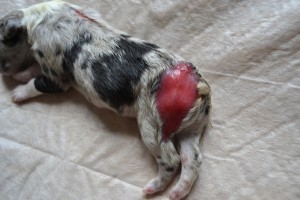About one Australian Shepherd in five will have a naturally bobbed tail, according to registration statistics from the time that the trait was still listed on registration certificates. Normal tail length and number of vertebrae varies considerably in dogs, though the number within a breed will be the same or perhaps vary by one or two. Normal tails taper; the vertebrae get smaller as you move toward the end, giving the impression of a point. In a bobtail, some of the vertebrae are missing; the end of the tail will be somewhat blunt. The 2009-10 ASHGI health survey data indicated that about 47% of NBT Aussies have tails are quarter-length or longer and 10% of them had kinked tails.
The gene known to cause bob-tail has been found in Aussies. It is an incomplete dominant, like merle. Puppies that inherit two copies die early and are reabsorbed, resulting in reduced litter size. Dogs with one copy are NBT. This gene does not determine tail length in NBTs or whether the tail is straight or crooked. Those traits may be controlled by other genes or regulatory DNA.

NBT dogs should not be bred to each other, particularly if the tails are very short NBTs. Doing so can produce puppies with spina bifida or other lower spinal cord defects. The ASHGI survey also found that 2% of breeding dogs were reported to have produced NBTs with defects bad enough to require euthanasia. Given that this is a percentage of all the breeding dogs in the survey many of whom were not NBT, actual percentage in NBTxNBT crosses might be even higher.
